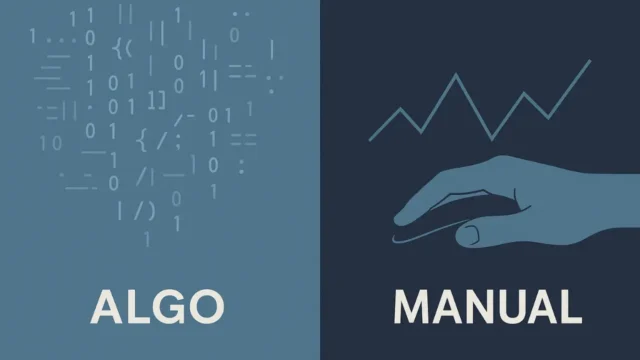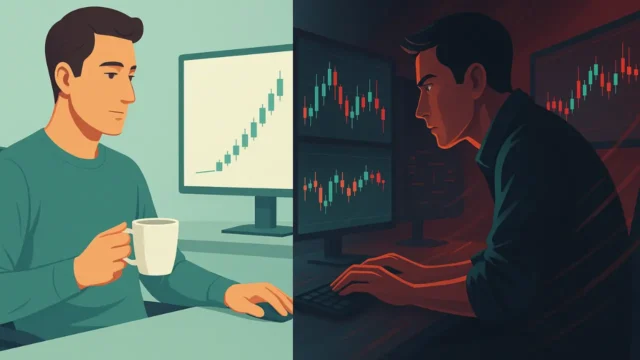Follow Us
Day Trading vs Swing Trading: Which is Better?

Table of Contents
Every aspiring trader eventually faces the same question: Day Trading vs Swing Trading: which is better?
Both strategies dominate the trading world, but they couldn’t be more different in pace, psychology, and lifestyle demands.
Day traders thrive on fast decisions and constant screen time, while swing traders focus on catching broader moves across days or weeks.
The confusion is understandable. Both methods promise profitability, but each comes with unique risks and rewards. Choosing the wrong style can burn out even the most disciplined trader.
Key Takeaways: Day Trading vs Swing Trading
- Day trading demands full-time focus, fast decisions, and a high tolerance for stress.
- Swing trading allows more flexibility, suits strategic thinkers, and fits around other commitments.
- The biggest differences are in time commitment, risk exposure, and psychological pressure.
- The right choice comes down to your lifestyle, mindset, and how you handle risk and uncertainty.
Overview of Day Trading
Day trading is the art of entering and exiting trades within the same market session. No positions are held overnight, which means traders avoid unexpected news risk while markets are closed.
Core Characteristics of Day Trading:
- Timeframe: Minutes to hours.
- Number of Trades: Depends on the style of Day trading & the trader.
- Goal: Capture intraday volatility and profit from small but frequent moves.
- Instruments: Stocks, futures, options, forex, and crypto.
Day traders rely on high liquidity markets because they need to get in and out quickly without large spreads eating into profits.
Trader Psychology: This style rewards fast thinkers who can make quick decisions under pressure. However, it can be mentally exhausting. The constant need to monitor screens makes day trading unsuitable for anyone with limited time.
Overview of Swing Trading
Swing trading operates on the opposite philosophy. Instead of chasing intraday moves, swing traders ride broader trends. Trades typically last from a few days to several weeks, giving more flexibility for those who can’t sit in front of screens all day.
Core Characteristics of Swing Trading:
- Timeframe: Days to weeks.
- Number of Trades: Often 2–10 per week.
- Goal: Capture bigger moves within an overall trend.
- Instruments: Stocks, ETFs, forex, crypto; any market where trends persist.
Swing traders use technical analysis to identify entry and exit points but also often consider fundamental events (earnings, macroeconomic data, sector trends) since trades may span news cycles.
Trader Psychology: Swing trading suits patient individuals who prefer strategic planning over rapid-fire decisions. But patience cuts both ways; it requires resisting the urge to interfere with trades once set, a challenge for many new traders.
Brief History & Market Context
The rise of day trading is closely tied to the late 1990s tech boom, when direct-access brokers and electronic communication networks (ECNs) made fast execution available to retail traders.
Cheap commissions and real-time data created an environment where individuals could compete with professionals on intraday price moves. The dot-com bubble attracted thousands of day traders, though many were wiped out when volatility collapsed in the early 2000s.
Swing trading, however, has older roots. Long before electronic platforms, investors were already holding positions over days and weeks based on chart patterns, fundamentals, or seasonal trends. The style gained renewed popularity during the 2008–09 financial crisis and the crypto bull runs, when volatility created sustained multi-day moves.
Today, both strategies coexist. Zero-commission brokers, tighter spreads, and high volatility post-2020 have fueled a surge in day trading. At the same time, swing trading appeals to those balancing trading with full-time jobs, especially in markets like crypto that move 24/7.
Key Differences: Day Trading vs Swing Trading
| Factor | Day Trading | Swing Trading |
|---|---|---|
| Time Commitment | Full-time; constant screen monitoring | Part-time; check markets a few times a day |
| Holding Period | Minutes to hours; no overnight risk | Days to weeks; carries overnight risk |
| Number of Trades | 1–10+ per day | 2–10+ per week |
| Risk Level | High – rapid losses possible | Moderate – wider stops but lower trade frequency |
| Psychological Demands | Intense focus, discipline, emotional control | Patience, strategic thinking, tolerance for overnight gaps |
| Market Conditions Needed | Works best in high volatility & liquid markets | Works best in trending or range-expansion phases |
| Costs | High commissions/spreads due to frequent trades | Lower costs since fewer trades |
Why this matters:
- Traders with limited time simply cannot sustain day trading’s screen demands.
- Traders with lower capital often find swing trading more accessible.
- The psychological challenge differs: day trading punishes hesitation, while swing trading punishes impatience.
Pros & Cons of Each Style
Day Trading Pros
- No overnight risk (earnings surprises, geopolitical events).
- Potentially fast profits within a single session.
- Clear daily reset: every day is a new trading event.
- Thrilling, high-adrenaline environment for those who enjoy speed.
Day Trading Cons
- Requires full-time commitment and intense focus.
- High stress and emotional strain.
- Higher commissions and costs.
Swing Trading Pros
- Flexible schedule; does not require all-day monitoring.
- Lower transaction costs per week.
- Bigger profit potential per trade compared to scalping/day trading.
- Allows integration of both technical and fundamental analysis.
Swing Trading Cons
- Overnight and weekend risk (gaps, news shocks).
- Requires patience and discipline to hold through volatility.
- Profits take longer to realize compared to intraday trading.
- Can be frustrating in choppy, sideways markets.
Tools & Indicators Commonly Used
While both styles rely heavily on technical analysis, the tools and setups they prioritize are quite different.
Day Trading Tools & Indicators:
- Live Market Depth: To see real-time order flow.
- VWAP (Volume Weighted Average Price): Helps gauge institutional activity.
- Momentum Indicators: RSI, MACD, and stochastic oscillators for intraday setups.
- Fast Trading Platforms: Speed is everything; advanced software with one-click execution is a must.
Swing Trading Tools & Indicators:
- Moving Averages (50/200-day): Identify broader trend direction.
- Fibonacci Retracements: Popular for spotting pullbacks in trends.
- Chart Patterns: Flags, triangles, head & shoulders for multi-day setups.
- Fundamental Catalysts: Earnings reports, interest rate decisions, or sector rotations that drive multi-week moves.
While day traders thrive on immediacy, swing traders depend more on trend confirmation and risk/reward positioning.
Who Should Choose Day Trading vs Who Should Choose Swing Trading

The best trading style depends as much on personality as it does on capital and time.
Day Trading Personality Profile:
- Thrives in fast-paced, high-pressure environments.
- Has the discipline to cut losses quickly.
- Enjoys being fully immersed in markets during the day.
- Willing to dedicate full-time hours to trading.
Swing Trading Personality Profile:
- Prefers a strategic, big-picture approach.
- Comfortable holding positions through uncertainty.
- Wants trading to fit around other commitments (job, family, business).
- More patient by nature, less emotionally reactive to short-term price swings.
Rule of Thumb: If you love adrenaline and thrive under pressure, day trading could suit you. If you value flexibility and prefer fewer, higher quality trades, swing trading may be your match.
Common Mistakes When Choosing Between These Styles
Even though both day trading and swing trading can be profitable, many beginners stumble into traps when choosing which to pursue.
1. Underestimating the Stress of Day Trading
New traders often believe they can handle the pace, but constant monitoring, split-second decision-making, and repeated losses can lead to burnout quickly.
2. Swing Traders Overtrading
Instead of letting trades breathe over days or weeks, many beginners check charts obsessively and cut positions too early. This undermines the very advantage of swing trading: giving trades time to play out.
3. Mismatched Lifestyle Choices
A working professional who can only check markets twice a day trying to day trade is setting themselves up for failure. Likewise, someone with ample time and capital who loves action may get bored waiting days in swing positions.
Choosing a style without matching it to your capital, time, and temperament is the fastest way to fail.
Verdict: Which is Better and Why It Depends
So, Day Trading vs Swing Trading – which is better?
The answer depends on you.
Day Trading is better if you:
- Can dedicate full-time hours to the market.
- Thrive in high-pressure, adrenaline-driven environments.
- Have sufficient capital to execute several trades simultaneously.
- Are disciplined with stop losses and quick decision making.
Swing Trading is better if you:
- Prefer flexibility and don’t want to be tied to screens all day.
- Have a full-time job or other commitments.
- Are comfortable holding through overnight gaps and news risk.
- Value patience and a slower pace of decision-making.
For most beginners, swing trading is often the more practical starting point. It allows traders to learn technical analysis, risk management and psychology without the extreme time and stress demands of day trading.
However, if your lifestyle and capital allow it and you truly enjoy the intensity; day trading can be more rewarding in terms of daily engagement and rapid results.
FAQs
Is day trading riskier than swing trading?
Yes, primarily due to its fast pace, leverage use, and frequent decision-making. But swing trading carries overnight risk, which can also lead to sharp losses.
Can you start with swing trading and move to day trading?
Absolutely. Many traders begin with swing trading to learn charting and psychology, then move to day trading once they gain confidence.
Which style is more profitable long-term?
Neither guarantees higher profits. Profitability depends more on your discipline, risk management, and ability to stick to a good strategy.
Conclusion: Helping Traders Decide Wisely
The Day Trading vs Swing Trading debate has no universal winner. Both strategies have built successful traders and destroyed accounts in equal measure.
The real difference lies not in the strategies themselves but in the fit between trader and style.
If you are someone who enjoys fast paced action, thrives under pressure, and can commit full-time to the markets, day trading may be the better fit.
You will face steep learning curves, capital requirements, and intense psychological challenges, but the reward is the ability to generate daily opportunities without overnight risks.
If you prefer a more balanced, strategic approach that leaves time for other commitments, swing trading might serve you better. It teaches patience, rewards planning, and requires less capital, making it the more accessible option for most beginners.
The smartest path forward?
Experiment with both in a simulated environment before committing real money. Track your performance, stress levels, and enjoyment. Let your results and personal comfort guide you.
At the end of the day, which is better is not about the market, it’s about you.
The more you understand yourself not just the markets; the easier it will be to pick a trading style that keeps you not just profitable, but consistent.
Disclaimer:
This content is for informational purposes only and should not be considered financial advice.
Read full Disclaimer.




